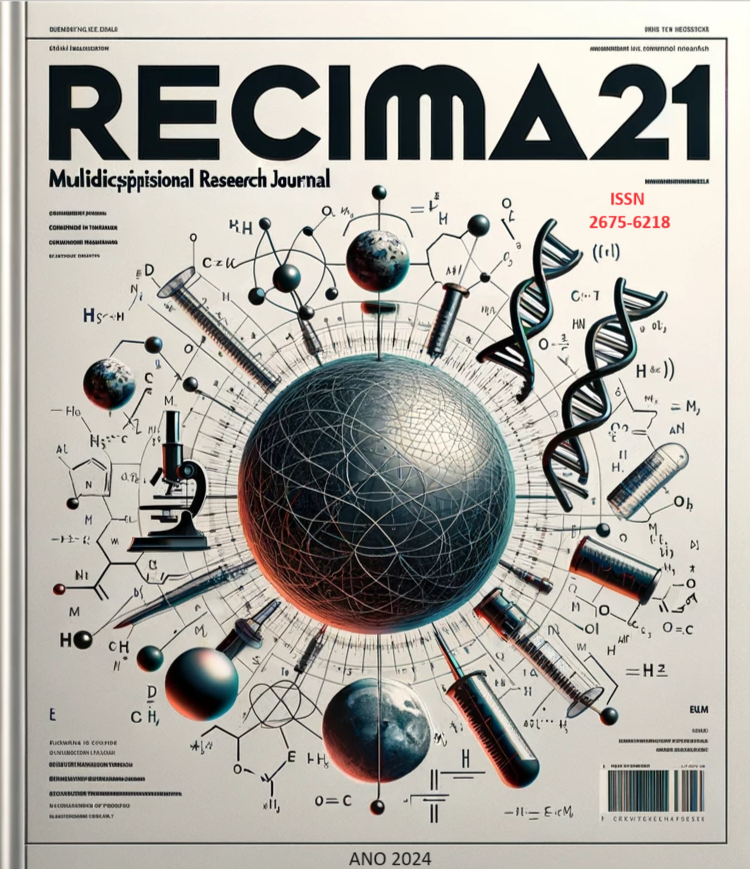ELECTROCHEMOTHERAPY AS A TREATMENT OPTION FOR BASAL CELL CARCINOMA
DOI:
https://doi.org/10.47820/recima21.v5i2.4847Keywords:
Cancer. Chemotherapy. Skin.Abstract
Introduction: Basal cell carcinoma (BCC), a skin carcinoma derived from epidermal cells, is the most common malignant tumor in humans. Excisional surgery and Mohs stage resection are the most effective treatments for low- and high-risk basal cell carcinomas. During the last decades, electrochemotherapy (ECT) has become an appreciated locoregional therapy in the field of dermato-oncology. Objectives: to evaluate the effectiveness of ECT in the treatment of basal cell carcinomas. Materials and methods: This is an integrative review, in which the guiding question was “Is electrochemotherapy an effective and safe option in the treatment of patients with basal cell carcinoma?” The search for articles took place in PubMed using the terms “basal cell carcinoma”, “cisplatin”, “electrochemotherapy” and “bleomycin”. Results and discussion: Electrochemotherapy is a treatment option that can be offered when surgery or radiotherapy are not viable or contraindicated. Electrochemotherapy provides its antitumor effect through the permeabilization of cancer cells to chemotherapy agents through short and high voltage electrical pulses that destabilize the cell membrane barrier, allowing their intracellular access. The main advantages of electrochemotherapy are high local tumor control with minimal damage to normal tissue, limited side effects and good cost/benefit ratio. Conclusion: When excision is not feasible, ECT is a safe and reasonably effective alternative, with a greater chance of success in untreated individuals, whose tumors are completely covered with electrical pulses.
Downloads
References
BERTINO, Giulia et al. European Research on Electrochemotherapy in Head and Neck Cancer (EURECA) project: Results of the treatment of skin cancer. European Journal of Cancer, v. 63, p. 41-52, 2016. DOI: https://doi.org/10.1016/j.ejca.2016.05.001
BERTINO, Giulia et al. Treatment of basal cell carcinoma with electrochemotherapy: insights from the inspECT registry (2008–2019). Current Oncology, v. 29, n. 8, p. 5324-5337, 2022. DOI: https://doi.org/10.3390/curroncol29080423
CAMPANA, L. G. et al. Treatment efficacy with electrochemotherapy: A multi-institutional prospective observational study on 376 patients with superficial tumors. European Journal of Surgical Oncology (EJSO), v. 42, n. 12, p. 1914-1923, 2016. DOI: https://doi.org/10.1016/j.ejso.2016.06.399
CAMPANA, Luca G. et al. Basal cell carcinoma: 10-year experience with electrochemotherapy. Journal of translational medicine, v. 15, p. 1-12, 2017. DOI: https://doi.org/10.1186/s12967-017-1225-5
CLOVER, A. J. P. et al. Electrochemotherapy for the treatment of primary basal cell carcinoma; A randomised control trial comparing electrochemotherapy and surgery with five year follow up. European Journal of Surgical Oncology, v. 46, n. 5, p. 847-854, 2020. DOI: https://doi.org/10.1016/j.ejso.2019.11.509
DE SOUSA, Luís Manuel Mota et al. A metodologia de revisão integrativa da literatura em enfermagem. Revista investigação em enfermagem, v. 21, n. 2, p. 17-26, 2017.
ERCOLE, Flávia Falci; MELO, Laís Samara de; ALCOFORADO, Carla Lúcia Goulart Constant. Revisão integrativa versus revisão sistemática. Reme: Revista Mineira de Enfermagem, v. 18, n. 1, p. 09-11, 2014. DOI: https://doi.org/10.5935/1415-2762.20140001
ESMAEILI, Nazila et al. Electrochemotherapy: A review of current status, alternative IGP approaches, and future perspectives. Journal of healthcare engineering, v. 2019, 2019. DOI: https://doi.org/10.1155/2019/2784516
HENDEL, K. et al. Electrochemotherapy with bleomycin for basal cell carcinomas: A systematic review. Journal of the European Academy of Dermatology and Venereology, v. 35, n. 11, p. 2208-2215, 2021. DOI: https://doi.org/10.1111/jdv.17492
LYONS, Phoebe; KENNEDY, Alison; CLOVER, A. James P. Electrochemotherapy and basal cell carcinomas: First-time appraisal of the efficacy of electrochemotherapy on survivorship using FACE-Q. JPRAS open, v. 27, p. 119-128, 2021. DOI: https://doi.org/10.1016/j.jpra.2020.12.004
MENDES, Karina Dal Sasso; SILVEIRA, Renata Cristina de Campos Pereira; GALVÃO, Cristina Maria. Revisão integrativa: método de pesquisa para a incorporação de evidências na saúde e na enfermagem. Texto & contexto-enfermagem, v. 17, p. 758-764, 2008. DOI: https://doi.org/10.1590/S0104-07072008000400018
PERIS, Ketty et al. EUROPEAN CONSENSUS-BASED INTERDISCIPLINARY GUIDELINE FOR DIAGNOSIS AND TREATMENT OF BASAL CELL CARCINOMA–UPDATE 2023. European Journal of Cancer, p. 113254, 2023. DOI: https://doi.org/10.1016/j.ejca.2023.113254
PETERSON, Shelby C. et al. Basal cell carcinoma preferentially arises from stem cells within hair follicle and mechanosensory niches. Cell stem cell, v. 16, n. 4, p. 400-412, 2015. DOI: https://doi.org/10.1016/j.stem.2015.02.006
Downloads
Published
How to Cite
License
Copyright (c) 2024 RECIMA21 - Revista Científica Multidisciplinar - ISSN 2675-6218

This work is licensed under a Creative Commons Attribution 4.0 International License.
Os direitos autorais dos artigos/resenhas/TCCs publicados pertecem à revista RECIMA21, e seguem o padrão Creative Commons (CC BY 4.0), permitindo a cópia ou reprodução, desde que cite a fonte e respeite os direitos dos autores e contenham menção aos mesmos nos créditos. Toda e qualquer obra publicada na revista, seu conteúdo é de responsabilidade dos autores, cabendo a RECIMA21 apenas ser o veículo de divulgação, seguindo os padrões nacionais e internacionais de publicação.













